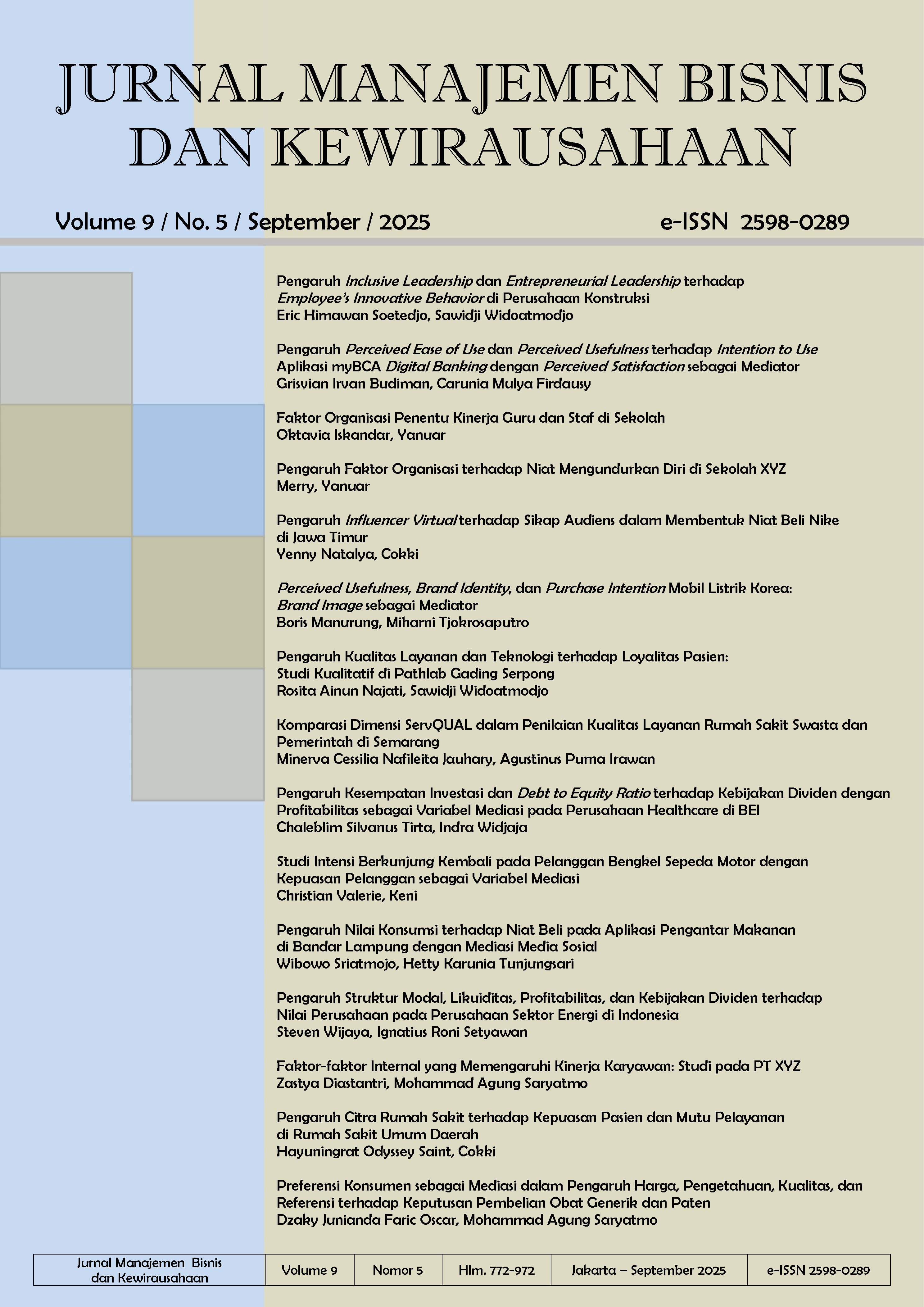Pengaruh perceived ease of use dan perceived usefulness terhadap intention to use aplikasi myBCA digital banking dengan perceived satisfaction sebagai mediator
Main Article Content
Abstract
This study aims to analyze the influence of perceived ease of use and perceived usefulness on intention to use the myBCA application with perceived satisfaction as a mediator. Data were collected from 160 users of myBCA digital banking application in the Greater Jakarta area (Jabodetabek) through purposive sampling and analyzed using SmartPLS version 4.1.0.0. The results reveal that perceived usefulness and perceived satisfaction have a positive and significant effect on intention to use the myBCA application, while perceived ease of use does not have a significant effect on intention to use the myBCA application. Nevertheless, both perceived ease of use and perceived usefulness significantly influence perceived satisfaction. Furthermore, perceived satisfaction fully mediates the effect of perceived ease of use on intention to use the myBCA application and partially mediates the effect of perceived usefulness on intention to use the myBCA application.
Penelitian ini bertujuan untuk menganalisis pengaruh perceived ease of use dan perceived usefulness terhadap intention to use aplikasi myBCA dengan perceived satisfaction sebagai mediator. Data dikumpulkan dari 160 pengguna aplikasi myBCA di wilayah Jakarta, Bogor, Depok, Tangerang, dan Bekasi (Jabodetabek) melalui teknik purposive sampling dan dianalisis menggunakan SmartPLS versi 4.1.0.0. Hasil analisis mengungkapkan bahwasanya perceived usefulness dan perceived satisfaction berpengaruh positif dan signifikan terhadap intention to use aplikasi myBCA, sementara perceived ease of use tidak berpengaruh signifikan terhadap intention to use aplikasi myBCA. Meskipun demikian, baik perceived ease of use maupun perceived usefulness berpengaruh signifikan terhadap perceived satisfaction. Selanjutnya, perceived satisfaction memediasi secara penuh pengaruh perceived ease of use terhadap intention to use aplikasi myBCA serta memediasi secara parsial pengaruh perceived usefulness terhadap intention to use aplikasi myBCA.
Article Details

This work is licensed under a Creative Commons Attribution-NonCommercial-ShareAlike 4.0 International License.
This work is licensed under a Jurnal Manajemen Bisnis dan Kewirausahaan Creative Commons Attribution-ShareAlike 4.0 International License.
References
Ahmed, S., Ashrafi, D. M., Paraman, P., Dhar, B. K., & Annamalah, S. (2023). Behavioural intention of consumers to use app-based shopping on green tech products in an emerging economy. International Journal of Quality & Reliability Management, 41(6), 1496-1518. doi:https://doi.org/10.1108/IJQRM-05-2023-0164
Ajzen, I. (1991). The theory of planned behavior. Organizational Behavior and Human Decision Processes, 50(2), 179-211. doi:https://doi.org/10.1016/0749-5978(91)90020-T
Al-Hawamleh, A. M. (2024). Exploring the satisfaction and continuance intention to use e-learning systems: an integration of the information systems success model and the technology acceptance model. International Journal of Electrical and Computer Engineering Systems, 15(2), 201-214. doi:10.32985/ijeces.15.2.8
Chemingui, H., & Lallouna, H. B. (2013). Resistance, motivations, trust and intention to use mobile financial services. International Journal of Bank Marketing, 31(7), 574-592.
Davis, F. D. (1989). Perceived usefulness, perceived ease of use, and user acceptance of information technology. MIS quarterly, 319-340.
Ghozali, I. (2020). 25 grand theory: teori besar ilmu manajemen, akuntansi, dan bisnis. Semarang: Yoga Pratama.
Irawan, H. (2018). Membedah strategi kepuasan pelanggan. Jakarta: PT Gramedia.
Joudeh, J. M., Omeish, F., Haddad, N. A., & Badran, O. N. (2024). An evaluation of the determinants affecting students’ satisfaction and intention to use e-learning tools: A study based on the technology acceptance model. Journal of Infrastructure, Policy and Development, 8(8), 1-16. doi:https://doi.org/10.24294/jipd.v8i8.6218
Kasemin. (2015). Agresi perkembangan teknologi informasi. Jakarta: Prenada Media Group.
Kotler, P., & Keller, K. L. (2018). Perilaku konsumen (sikap dan pemasaran) (M. A. Firmansyah, Trans.). Pasuruan: CV. Penerbit Qiara Media.
Laras, A. (2024, Mei 29). Bisnis.com. Retrieved from Finansial: Rapor pengguna mobile banking bank jumbo kuartal I/2024: BRI teratas, Mandiri melesat! https://finansial.bisnis.com/read/20240529/90/1769456/rapor-pengguna-mobile-banking-bank-jumbo-kuartal-i2024-bri-teratas-mandiri-melesat
Legramante, D., Azevedo, A., & Azevedo, J. M. (2023). Integration of the technology acceptance model and the information systems success satisfaction and continuity of use. The International Journal of Information and Learning Technology, 467-484. doi:10.1108/IJILT-12-2022-0231
Leon, S. (2018). Service mobile apps: a millennial generation perspective. Industrial Management & Data Systems, 118 (9), 1837-1860.
Lombu, W., & Wardana, I. M. (2024). The role of satisfaction in mediating the influence of perceived usefulness and perceived ease of use on the intention to reuse Ovo e-wallet. International Journal of Economics, Commerce, and Management, 384-396. doi:https://doi.org/10.62951/ijecm.v1i4.261
Ludeña-Poma, J., Rojas-Gallegos, S., Solano-Ortiz, L., Castro-Chavez, Y., Chahua-Borda, D., & Ludeña-Poma, J. (2024). Influence of resistance to use, perceived ease of use, perceived usefulness, and facilitating conditions in the intention to use telemedicine in Peru. Pharmacia, 1-11. doi:https://doi.org/10.3897/pharmacia.71.e118004
Paramananda, K. A., & Sukaatmadja, I. P. (2024). The role of user satisfaction in mediating the effect of perceived ease of use and perceived usefulness on reuse intention (Study of Tiket.com users in Denpasar City). International Journal of Social Service and Research, 4(7), 1-11. doi:10.46799/ijssr.v4i7.858
Phuangsuwan, P., Siripipatthanakul, S., Chaiprakarn, S., & Puangsang, M. (2024). Investigating intentions to use Google Maps for travelling among users. RMUTT Global Business and Economics Review, Pathum Thani, Thailand, 19(1), 91-110. doi:https://doi.org/10.60101/rmuttgber.2024.270317
Sharabati, A.-A. A., AL-Haddad, S. I., Khasawneh, M. H., Nababteh, N., Mohammad, M., & Ghoush, Q. A. (2022). The impact of TikTok user satisfaction on continuous intention to use the application. Journal of Open Innovation: Technology, Market, and Complexity, 8(3), 1-20. doi:10.3390/joitmc8030125
Wetzel, M., Odekerken, G., & Oppen, C. V. (2009). Using PLS path modeling for assessing hierarchical construct models: Guidelines and empirical illustration. MIS Quarterly, 33(1), 177-195. doi:10.2307/20650284
Yadav, R., & Pathak, G. S. (2017). Determinants of consumers' green purchase behavior in a developing nation: Applying and extending the theory of planned behavior. Ecological Economic, 134, 114-122.


